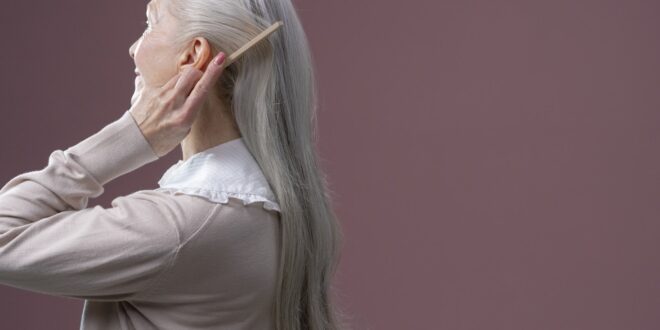Professional Tips you Wish you’d Known Sooner!
As we age, our bodies change – and that includes our hair. We stop producing the pigment that gave our hair its natural colour, and begin to ‘turn grey’. Our hair takes on a different texture, too, with most of it becoming harder, ‘glassier’, and less willing to ‘sit up and be styled’. Even more infuriating, our hair is less able to absorb the colour we may decide to introduce into it. Hair also thins (for both men and women), and it can change appearance at the hair line.
As with most aspects of growing older, thought and planning are required to work around new challenges. That’s why we asked a trusted hair stylist, experienced at working with senior clients, for her advice. In this first of a two part series, we look at ‘going grey’, ‘scalp care’ and ‘conditioning’.
‘Going grey’
- Don’t be afraid to ‘go grey’. If you decide, in the end, that it’s not for you, you can always change your mind.
- If you do decide to ‘go grey’, ‘transitioning’ can be the most challenging period to manage in terms of looking your best. That’s why it can pay to have your hair coloured by a stylist until the majority of your original natural colour has gone. Your stylist will advise when the time is right to fully embrace your new natural colour.
- If you decide to ‘go grey’ on a permanent basis, it’s more important than ever to focus on style and styling products. That’s because loss of pigment brings with it other changes such as loss of fullness and bounce – factors which ‘product’ can mitigate.
- When embracing grey, experiment with a purple shampoo. It is a major tool in helping keep grey hair fresh and bright.
Scalp care
Our scalp tends to become more ‘scurfy’ as we age, which is why many older people experience dandruff for the first time. However, rather than dandruff being caused by physical changes with our scalp as we age, it may actually be more connected with our ability to manage hair washing as we once did. As shoulders, arms, hands, and fingers are affected by the likes of arthritis, or our energy levels wane, the number of times we wash our hair each week reduces. We may also cut back on shampooing and conditioning in order to save money. The result is we may wash our hair just once or twice a week instead of every day.
The reduction of scalp stimulation that comes with less frequent washing means dead skin cells (surf) build up and up, eventually working their way through our hair and onto our clothes. The following are ways to overcome the problem of dandruff:
- Brush your hair well (or ask someone else to do this for you) before you shampoo. This will help loosen dead skin cells from your scalp.
- If cost isn’t an issue, shampoo your hair twice, each time you wash it, rinsing thoroughly between applications. The first shampoo will loosen the scurf, while the second will help remove it.
Conditioning
- If you are only washing your hair once a week, definitely shampoo it twice, and always follow up with a conditioner.
- Consider using a spray-and-leave-in conditioner. Cream conditioners can ‘overwhelm’ older hair, and leave it looking lank.
- Rather than using a generic conditioner, ask your stylist to recommend one to suit your hair, specifically.
In Part 2 of Hair Care for Seniors, we’ll be taking a look at colour, product, thinning, and how you can help your friend or partner retain the hair style they want. Happy hair-caring!








Gaynor Brown - 2 years ago
My wonderful hairdresser told me that I am not grey haired but SENIOR BLONDE …I love it.